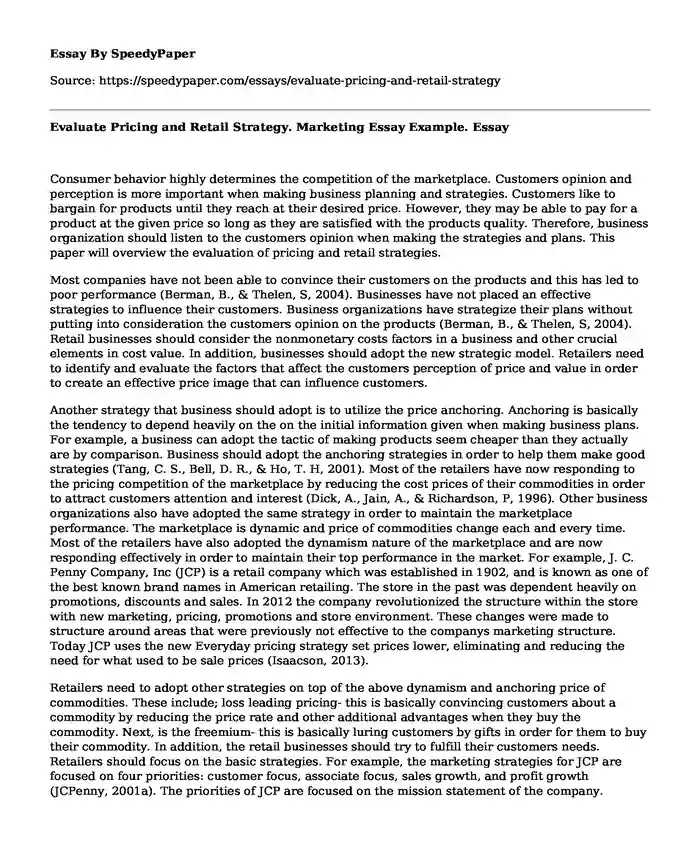Consumer behavior highly determines the competition of the marketplace. Customers opinion and perception is more important when making business planning and strategies. Customers like to bargain for products until they reach at their desired price. However, they may be able to pay for a product at the given price so long as they are satisfied with the products quality. Therefore, business organization should listen to the customers opinion when making the strategies and plans. This paper will overview the evaluation of pricing and retail strategies.
Most companies have not been able to convince their customers on the products and this has led to poor performance (Berman, B., & Thelen, S, 2004). Businesses have not placed an effective strategies to influence their customers. Business organizations have strategize their plans without putting into consideration the customers opinion on the products (Berman, B., & Thelen, S, 2004). Retail businesses should consider the nonmonetary costs factors in a business and other crucial elements in cost value. In addition, businesses should adopt the new strategic model. Retailers need to identify and evaluate the factors that affect the customers perception of price and value in order to create an effective price image that can influence customers.
Another strategy that business should adopt is to utilize the price anchoring. Anchoring is basically the tendency to depend heavily on the on the initial information given when making business plans. For example, a business can adopt the tactic of making products seem cheaper than they actually are by comparison. Business should adopt the anchoring strategies in order to help them make good strategies (Tang, C. S., Bell, D. R., & Ho, T. H, 2001). Most of the retailers have now responding to the pricing competition of the marketplace by reducing the cost prices of their commodities in order to attract customers attention and interest (Dick, A., Jain, A., & Richardson, P, 1996). Other business organizations also have adopted the same strategy in order to maintain the marketplace performance. The marketplace is dynamic and price of commodities change each and every time. Most of the retailers have also adopted the dynamism nature of the marketplace and are now responding effectively in order to maintain their top performance in the market. For example, J. C. Penny Company, Inc (JCP) is a retail company which was established in 1902, and is known as one of the best known brand names in American retailing. The store in the past was dependent heavily on promotions, discounts and sales. In 2012 the company revolutionized the structure within the store with new marketing, pricing, promotions and store environment. These changes were made to structure around areas that were previously not effective to the companys marketing structure. Today JCP uses the new Everyday pricing strategy set prices lower, eliminating and reducing the need for what used to be sale prices (Isaacson, 2013).
Retailers need to adopt other strategies on top of the above dynamism and anchoring price of commodities. These include; loss leading pricing- this is basically convincing customers about a commodity by reducing the price rate and other additional advantages when they buy the commodity. Next, is the freemium- this is basically luring customers by gifts in order for them to buy their commodity. In addition, the retail businesses should try to fulfill their customers needs. Retailers should focus on the basic strategies. For example, the marketing strategies for JCP are focused on four priorities: customer focus, associate focus, sales growth, and profit growth (JCPenny, 2001a). The priorities of JCP are focused on the mission statement of the company.
In conclusion, the market competition is highly dictated by the customer perception on products. This should be placed into consideration when making strategies and plans.
Works cited
Berman, B., & Thelen, S. (2004). A guide to developing and managing a well-integrated multi-channel retail strategy. International Journal of Retail & Distribution Management, 32(3), 147-156.
Dick, A., Jain, A., & Richardson, P. (1996). How consumers evaluate store brands. Journal of Product & Brand Management, 5(2), 19-28.
Tang, C. S., Bell, D. R., & Ho, T. H. (2001). Store choice and shopping behavior: How price format works. California Management Review, 43(2), 56-74.
Cite this page
Evaluate Pricing and Retail Strategy. Marketing Essay Example.. (2019, May 21). Retrieved from https://speedypaper.com/essays/evaluate-pricing-and-retail-strategy
Request Removal
If you are the original author of this essay and no longer wish to have it published on the SpeedyPaper website, please click below to request its removal:
- Free Essay on a Child With Learning Disability
- Free Essay about the United Nations Human Rights Council
- Free Essay on Strategic Management at IKEA
- Annotated Bibliography Example on Different Aspects of Cinema
- Free Essay Example on Pattern of Ownership
- Free Essay: Effective Communication Systems Within an Organization
- Essay Sample on Uber Kalanick Temporary Leave of Absence
Popular categories





